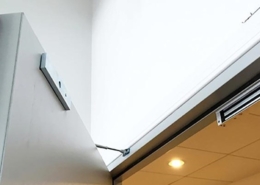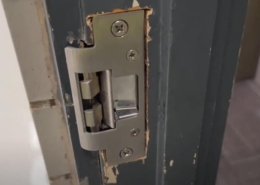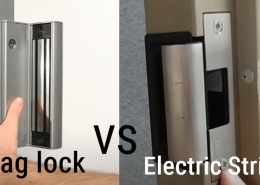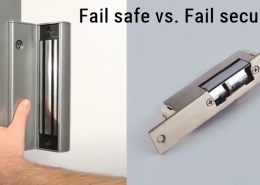Mag Lock vs. Electric Strike: Key Difference & How to Choose
Learn the key differences between Mag Lock vs. Electric Strike. This comprehensive guide deeply discusses it and helps you understand which lock type best suits your needs.
When securing your premises, choosing the right type of lock is crucial. Two popular types of electronic locks are magnetic locks, often referred to as ‘Mag Locks,’ and electric strikes. Both locks offer excellent security, but each has unique features, advantages, and potential applications.
This article will provide an in-depth comparison of mag locks and electric strikes, covering their operation, installation, strength, power requirements, and more.
What’s the key difference between a mag lock vs. an electric strike?
Magnetic locks (mag locks) and electric strikes are two electronic locking mechanisms often used in access control systems. Here are some of the key differences:
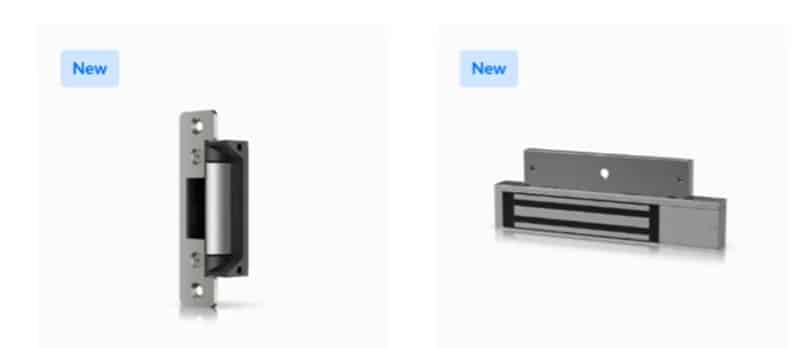
- How They Function
- Mag Locks operate by creating a magnetic field that secures the door. When the lock is energized, it attracts a metal plate on the door, keeping it locked. The power is cut off to unlock, breaking the magnetic field and opening the maglock.
- Electric Strikes work in conjunction with a mechanical lock. An electric strike replaces the fixed strike faceplate of a latch or deadbolt. When power is applied to the strike, it releases the latch or bolt, allowing the door to swing open.
- Strength
- Mag locks are typically very strong, often able to hold a door closed against thousands of pounds of force.
- Electric strikes can also be quite strong, but their strength is generally less than mag locks.
- Use:
- Magnetic Locks are often used on emergency exit doors, as they can be configured to release automatically during a fire or other emergency.
- Electric strikes are commonly used on doors where security is important but where it’s also necessary to be able to unlock the door from the inside without a key manually.
- Installation
- Mag Locks are typically surface-mounted to the door frame and the door, making them visibly more intrusive but easier to install.
- Electric Strikes are installed in the door frame and work with the existing door hardware, which makes them more discreet but may require more complex installation.
- Behavior during Power Loss
- Mag Locks are “fail-safe,” meaning they automatically unlock when power is lost. This can be a potential security risk during a power outage but is also a safety feature in emergencies.
- Electric Strikes can be either “fail-secure” or “fail-safe.” In a fail-secure configuration, the door remains locked when power is lost, keeping the area secure. In a fail-safe configuration, like a mag lock, the door would unlock in a power outage.
- Cost and Maintenance
- Mag Locks: Because they lack moving parts, mag locks require less maintenance than electric strikes. This can potentially reduce long-term costs. However, the initial cost of a mag lock can be higher, depending on the specific model and its holding force.
- Electric Strikes: These devices can have higher maintenance costs due to their mechanical components. Their initial cost varies widely based on the specific model and features.
Mag lock vs. electric strike: Pros and Cons
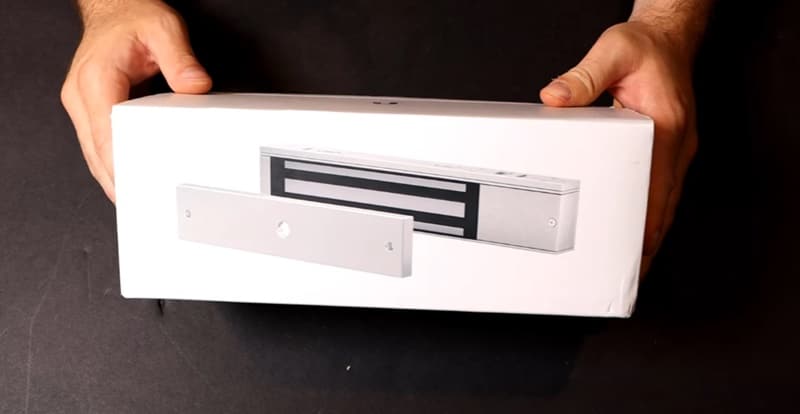
Magnetic Locks (Mag Locks)
Pros:
- High Security: Can hold a door closed against thousands of pounds of force. Electric locks often provide a higher level of security than electric strikes due to their high holding force.
- Simple to Use: No moving parts, reducing the chance of mechanical failure.
- Fail-Safe: Unlocks when power is lost, which can be a safety feature in emergencies.
- Compatibility: Works well with a wide range of door types and materials.
- Ease of Installation: Electromagnetic locks can be easier to install than electric strikes because they typically don’t require modification of the door or frame.
Cons:
- Power Dependence: Electromagnetic locks require constant power to remain locked. The magnetic lock may not work well in a power outage unless a backup power system exists.
- Fail-Safe: While this can be a pro regarding safety, it’s also a con for security during power outages unless backed up by a power supply system.
- Visibility: Usually surface-mounted, making them more noticeable than electric strikes.
- No Manual Override: It can’t be manually unlocked from the outside with a key, which can be problematic if the power is out and the backup system fails.
- Egress Considerations: Electric locks often don’t allow free egress unless paired with a request-to-exit (REX) device, which might not be suitable for all situations and can increase the system’s complexity.
Electric Strikes
Pros:
- Versatility: This can be configured as either fail-secure or fail-safe, depending on the application’s requirements.
- Compatibility: Electric strikes can work with various mechanical locks, making them versatile for different doors and frames.
- Manual Override: Can be manually unlocked from the outside with a key, providing an extra layer of security and convenience.
- Discreet: More discreet than mag locks because they are installed within the door frame.
- Free Egress: They often allow for free egress, meaning individuals inside the building can exit freely even when the door is locked outside.
Cons:
- Installation: These can be more complex to install because they require modification of the door frame.
- Mechanical Parts: Have moving parts that can wear out and require maintenance or replacement.
- Strength: Generally, not as strong as mag locks regarding holding force.
- Security: While they provide a significant level of security, electric strikes may not offer as much holding force as electromagnetic locks.
Mag lock vs. electric strike: Installation
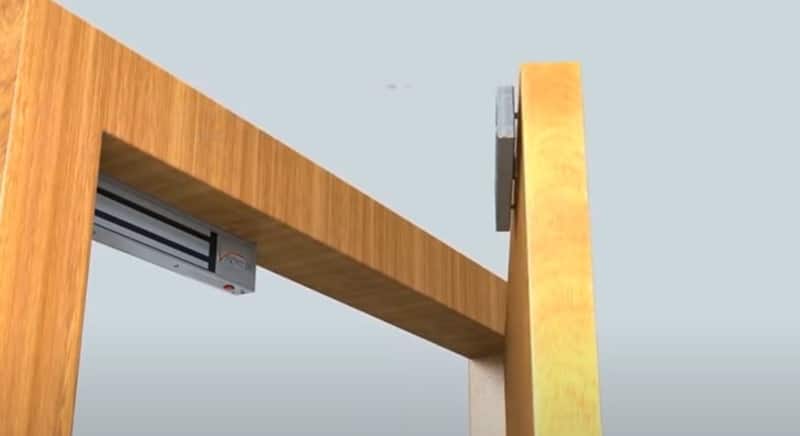
Magnetic Locks (Mag Locks) Installation
- Installing an electromagnetic lock typically involves mounting the electromagnet on the door frame or header and the corresponding armature plate on the door. The magnet and armature plate must align to ensure the door locks properly.
- Like electric strikes, electromagnetic locks also require wiring to be run to the power supply and any access control or security system. Because they require a constant power supply to remain locked, there might also be a need for a backup power system.
Electric Strikes Installation
- The installation of an electric strike often requires modifying the door frame. The existing strike plate for the mechanical lock is removed, and a hole is cut into the frame to accommodate the electric strike. The electric strike must be aligned correctly with the lock’s latch bolt to engage and disengage properly.
- Additionally, wiring must be run from the electric strike to the power supply and any access control or security system used. This can sometimes be complex, particularly if the wiring needs to be concealed for security or aesthetic reasons.
Mag lock vs. electric strike: Application
Magnetic locks (mag locks) and electric strikes are used in various applications, each with advantages that make them more suitable for certain uses.
Magnetic Locks (Mag Locks) Applications
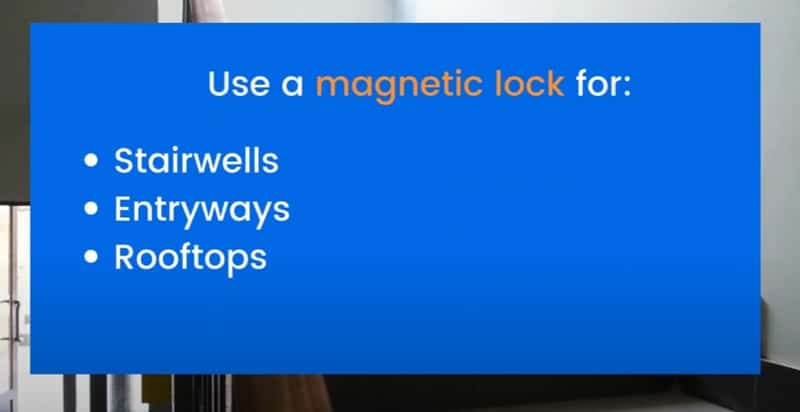
Magnetic locks are often used in high-security situations requiring a high holding force. They often don’t allow for free egress unless they’re paired with a request-to-exit (REX) device.
Mag locks are often used in the following settings:
- Hotel stairwells: Magnetic locks are usually used for fire doors in hotel stairwells to maintain the hotel’s safety under normal circumstances, and in emergencies such as fire, the automatic power-off unlocks the fire doors to ensure the safe escape of hotel personnel. At the same time, in the hotel, the magnetic lock can also be used with the hotel door lock system, and the hotel room card can be used to open the fire door of the hotel stairwell.
- High-Security Areas: Due to their high holding force, mag locks are often used in high-security areas such as data centers, research labs, or anywhere else that requires a high level of security.
- Emergency Exits: Since mag locks are fail-safe (they unlock when power is lost), they are commonly used on emergency exit doors to ensure people can safely exit the building in case of a power outage or fire.
- Large Commercial Buildings: Mag locks can also be used in large commercial buildings where there’s a need to control access to various building sections.
- Hotel
Electric Strikes Applications
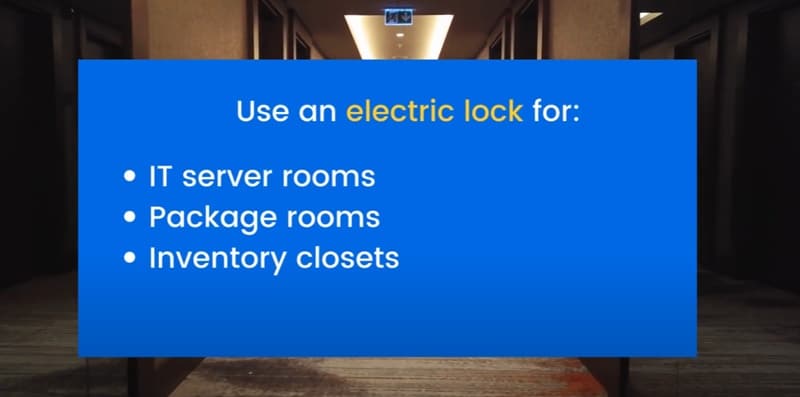
Electric strikes are typically used in commercial settings where it’s necessary to control access from both sides of a door, such as offices or retail spaces. They allow for free egress, meaning people inside the building can exit freely even when the door is locked from the outside. They are commonly used in:
- Commercial Offices: Electric strikes are commonly used in office buildings to control access to certain areas, like staff-only sections.
- Retail Businesses: Electric strikes can help control access to storage rooms or back offices in retail settings.
- Multi-Tenant Buildings: Electric strikes are often used on main entrance doors in apartment buildings or condos, allowing residents to open the door remotely for visitors.
- Schools and Universities: Electric strikes can control access to classrooms, labs, or other restricted areas.
In both cases, these locking systems can be integrated into broader access control systems. Security personnel can operate them using various methods, such as keycards, keypads, biometric readers, or remote control.
Mag lock vs. electric strike: Security Lever
Both magnetic locks (Mag Locks) and electric strikes offer significant security benefits, but there are some differences to consider:
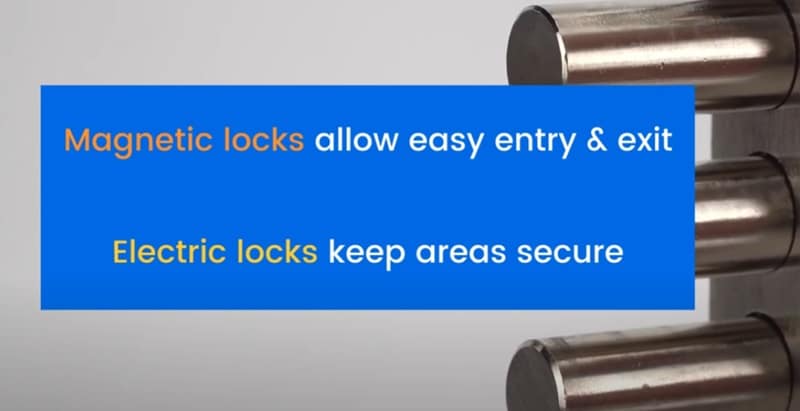
Magnetic Locks (Mag Locks)
- Mag locks can provide a high level of security due to their high holding force, which can resist thousands of pounds of force. This makes them very difficult to overcome without cutting power to the lock or damaging the door or frame.
Electric Strikes
- Electric strikes also provide a significant level of security. They are designed to work with a door’s existing lock so that the security level can be influenced by the type of mechanical lock used.
- One advantage of electric strikes is that they can be configured as either fail-safe or fail-secure. In a fail-secure configuration, the door remains locked from the outside even during a power failure, which can provide an additional level of security compared to a mag lock.
Mag lock vs. electric strike: Cost
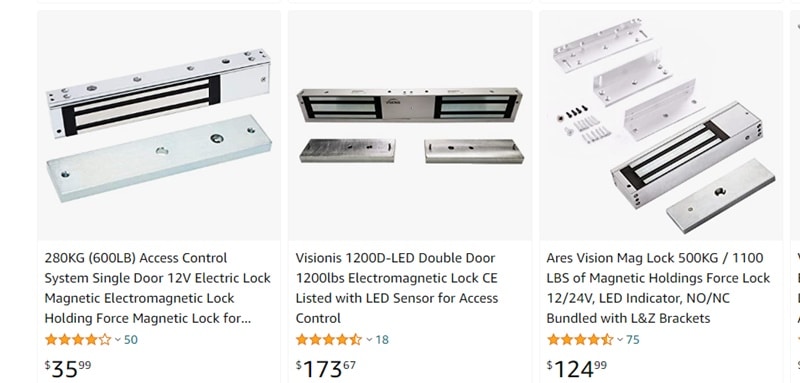
- Magnetic Locks (Mag Locks)Cost: A standalone mag lock can range from about $100 to $500 or more, depending on the holding force of the lock and its overall quality. However, keep in mind that a mag lock typically needs to be part of a larger access control system, so the total cost could be significantly higher when you factor in the cost of items like keypads, card readers, power supplies, and backup power systems, as well as professional installation.
- Electric Strikescost: Electric strikes can also range widely in price, from about $100 to $300 or more, depending on the quality and features of the strike.
Mag lock vs. electric strike: Power requirement
Both magnetic locks (Mag Locks) and electric strikes require electrical power. However, the specific power requirements can vary based on the model and the manufacturer’s specifications.

Magnetic Locks (Mag Locks)
- Mag locks require power to stay locked, so it’s important to have a reliable power source. A backup power system often ensures the lock remains functional during a power outage.
Electric Strikes
- In fail-secure mode, electric strikes require power to unlock, while fail-safe mode requires power to lock. The current draw can vary depending on the specific model of the electric strike.
As with any electronic device, it’s important to follow the manufacturer’s specifications for power requirements to ensure the lock operates effectively and safely. Improper power supply can lead to malfunctions or damage to the lock.
Electric strike vs. electric lock: Fire-Rated Doors Requirments
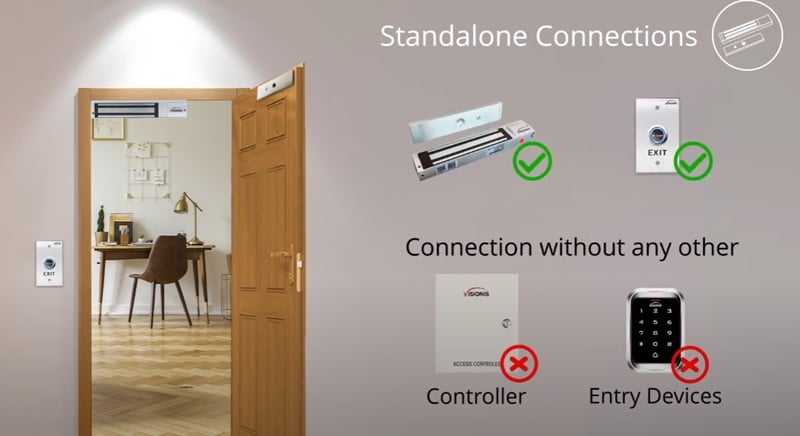
When dealing with fire-rated doors, it’s essential to maintain the integrity of the fire rating, which is designed to prevent the spread of fire and smoke. Therefore, any locking device installed on a fire-rated door must also comply with fire safety standards and regulations.
Electric Strikes on Fire-Rated Doors:
- Electric strikes can be used on fire-rated doors if the specific product is fire-rated. The fire-rated electric strike is designed to fail-secure, meaning the door remains locked even if power is lost. This is important during a fire because it helps maintain the fire door’s integrity. In a fire event, the door must remain closed to prevent the spread of fire and smoke.
Electric Locks (Electromagnetic Locks) on Fire-Rated Doors:
- Electromagnetic locks can also be used on fire-rated doors, but they are inherently fail-safe, meaning they unlock when power is lost. To comply with fire safety regulations, they are typically installed with a fire alarm interface that automatically cuts power to the lock in the event of a fire, allowing the door to close and preventing the spread of fire and smoke.
How to choose between mag lock vs. electric strike?
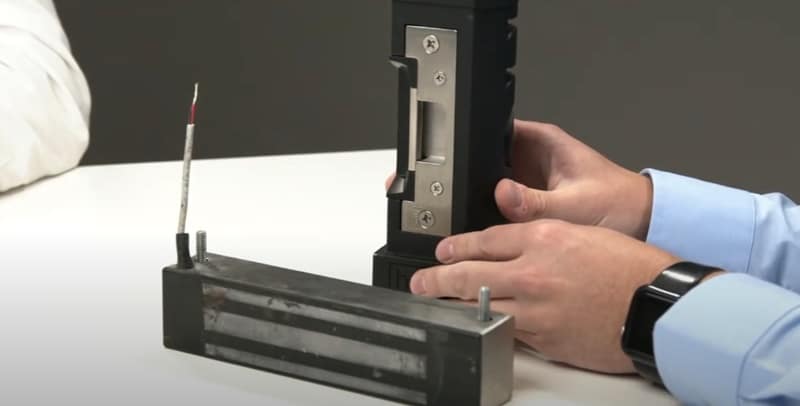
Choosing between a magnetic lock (mag lock) and an electric strike depends on various factors, each influencing the best choice for your situation. Here are some key factors to consider:
- Level of Security: If you require a high level of security with a strong holding force, a mag lock, which can resist thousands of pounds of force, could be the better option.
- Fire Safety Requirements: If the door is fire-rated, you need a locking device that maintains the integrity of the fire rating. An electric strike that is fire-rated and fails-secure can be a good option. If you’re considering an electromagnetic lock, you must ensure it has a fire alarm interface that automatically unlocks the door in the event of a fire.
- Access Control Requirements: If you need to integrate the lock with a broader access control system or require remote control of the lock, both electric strikes and electromagnetic locks can be good options.
- Egress Requirements: If you need free egress (the ability to exit without needing to unlock the door), an electric strike can often be a good option, as it allows the mechanical lock to be operated normally from the inside. If you’re considering an electromagnetic lock, you must ensure it is used with a request-to-exit (REX) device that allows for free egress.
- Installation Considerations: If modifications to the door or frame are a concern, an electromagnetic lock might be easier to install as it typically requires less modification than an electric strike.
- Cost: Consider both the upfront cost of the lock and the installation cost, as well as the ongoing costs of operation, maintenance, and potential upgrades. Remember that the cheapest option may not provide the level of security you need.
- Type of Door: Electric strikes are often used on doors that still require a mechanical lock, such as doors that need to be opened with a key from the outside. On the other hand, Mag locks are often used on doors without a mechanical lock, such as interior doors in commercial buildings.
- Power Supply and Fail-Safe or Fail-Secure Need: If the door needs to remain locked even during a power outage (fail-secure), an electric strike might be the better choice. A mag lock might be better if the door must unlock during a power outage (fail-safe), such as an emergency exit.
- Building Codes and Regulations: Some local building codes and regulations specify what types of locks can be used on certain doors. Always check the local regulations before making a decision.
Conclusion
In conclusion, magnetic locks and electric strikes play vital roles in modern access control systems, each offering unique benefits. With their high holding force, Mag locks offer substantial security and are ideal for high-traffic, high-security areas.
On the other hand, electric strikes offer flexibility with the fail-safe and fail-secure modes. They integrate well with traditional lock mechanisms, making them suitable for various applications.


